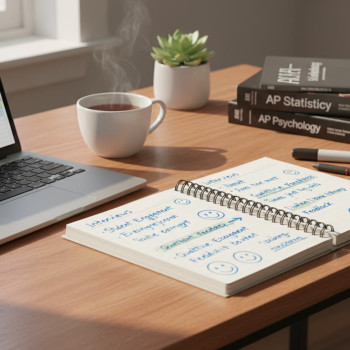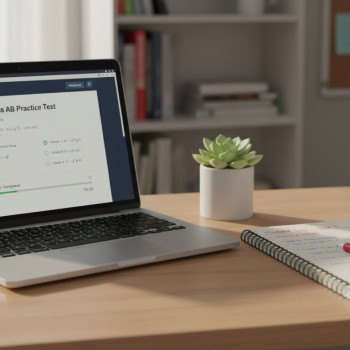Why Distraction Management Matters for AP Students
AP courses demand college-level thinking, sustained attention, and consistent practice. You’re not just memorizing facts; you’re learning how to analyze texts, solve complex problems, and construct persuasive arguments under time pressure. The problem is obvious: our phones, social apps, and multitasking habits chip away at the uninterrupted time those skills require. If you want to improve your AP scores, it’s not enough to study harder—you must study smarter by managing distractions.
This guide blends psychology-backed strategies with practical tools—like app blockers—and everyday rituals you can adopt starting today. It’s written for students who juggle classes, extracurriculars, jobs, and the social life that still matters. You’ll leave with a realistic, flexible plan to get focused when you study and relaxed when you rest.

First Principles: What Distraction Really Does to Learning
Understanding the impact of distraction makes it easier to change it. When you switch attention—say from a physics problem to a notification—you lose time and mental context. That lost context isn’t recovered instantly; it can take 15–25 minutes to refocus completely. Over a day of short interruptions, your efficient study time evaporates.
Here are the key cognitive consequences:
- Context switching reduces working memory efficiency.
- Frequent interruptions impair deep encoding, making material harder to recall on exam day.
- Stress and decision fatigue from constant interruptions lower motivation and the ability to execute complex tasks.
So the good news: reducing interruptions yields disproportionately large benefits. You don’t need perfection—small changes to your environment and routine produce measurable gains.
App Blockers: Your First Line of Defense
App blockers are tools that limit access to distracting apps or websites for set periods. They’re practical because they remove temptation rather than relying solely on willpower. For AP students, the right approach pairs app-blocking with clear study goals and rituals.
How to Use App Blockers Effectively
- Choose a goal first: Don’t start by blocking randomly. Set a study intention—e.g., “Complete two AP Calculus practice FRQs” or “Annotate and summarize one Biology chapter.”
- Set realistic blocks: Begin with 45–60 minute focused blocks. Many students find a 50/10 rhythm (50 minutes focused, 10 minutes break) or a Pomodoro-style 25/5 works best depending on stamina.
- Whitelist study tools: Allow access to educational resources like AP Classroom, practice PDFs, or calculators; block social media and entertainment sites during sessions.
- Use scheduled blocks for evenings: If you’re tempted to scroll before bed, schedule a stricter block for the last 60–90 minutes before sleep to improve memory consolidation and rest.
- Be flexible: On practice test days or during long build-up sessions, adjust block lengths to match exam conditions (e.g., simulate a 2-hour exam section).
Which Features to Look For
- Cross-device blocking so phone and laptop sync.
- Custom schedules to match class and homework routines.
- Locked mode or break penalties to prevent impulsive disabling.
- Activity reports to track progress and identify weak spots.
Remember: an app blocker is a scaffolding tool. Over time, your aim is not to be chained to an app but to internalize better habits. For many students, combining app blocking with a personalized study plan—like those offered through Sparkl’s personalized tutoring—makes the transition faster and more effective. Sparkl pairs tailored study plans with expert tutors who help students decide what to block and when.
Daily Rituals That Build Focus Muscle
Rituals are repeatable mini-habits that cue your brain to focus. Unlike strict rules, rituals are forgiving and psychologically powerful. Below are rituals students can adopt immediately.
Morning Rituals
- Wake time: Keep a consistent wake-up time even on weekends during AP season. Regular circadian rhythms improve concentration.
- Two-minute pre-study ritual: Make your bed, fill a water bottle, and spend two minutes reviewing your study intention. This signals the brain that learning time is starting.
- Quick review: Spend 10 minutes on spaced-repetition flashcards or reviewing yesterday’s notes to prime memory networks.
Pre-Study Rituals (Start Each Session the Same Way)
- Clear the desk: Remove unrelated books, headphones (unless you use them for focus music), and nonessential devices.
- Phone landing spot: Place your phone face-down in another room or a dedicated box with the app blocker activated.
- Set a measurable micro-goal: Write a single line like “Finish Section 3 FRQs” and set the timer.
- Do a quick breathing exercise: One minute of slow 4-4-4 breathing settles attention.
End-of-Session Rituals
- Summarize: Write two sentences about what you accomplished and one question you still have.
- Schedule the next block: Put the next session on your calendar within 24–48 hours to take advantage of spaced practice.
- Small reward: A quick walk, a snack, or a 10-minute check-in with friends—this closes the loop and sustains motivation.
Designing an AP-Focused Focus Plan
Not all study time is equal. A focused study plan aligns your highest energy blocks with the most cognitively demanding tasks—like timed practice essays, problem sets, or passage analysis—and uses low-energy windows for review or passive learning (videos, flashcards).
| Time of Day | Best Use | Suggested Rituals |
|---|---|---|
| Morning (High Energy) | Practice FRQs, problem solving, synthesis tasks | Phone off, 50–60 minute block, quiet space |
| Afternoon (Medium) | Content review, worked examples, flashcards | 25–45 minute Pomodoros, active recall |
| Evening (Low) | Review, light reading, passive videos | App blockers strict for last hour, relaxation routine |
This simple table can be adjusted to fit your school day. For example, if you have lab after school and fatigue is inevitable, schedule lighter tasks for that block and save heavy lifting for mornings or weekends.
Fast Tools and Tactics You Can Try Tonight
Immediate wins help build momentum. Try these tonight and reflect on what worked.
- Set one 50/10 block tomorrow with your phone in another room and a blocker on your laptop. Track how much you complete.
- Create a non-negotiable “no-screen” 30 minutes before bedtime to improve sleep and memory consolidation.
- Turn off non-essential notifications for 48 hours and notice the difference in focus.
- Use a two-day rule: during major study windows, avoid social apps for two consecutive days to reset compulsive checking. Then reintroduce them mindfully during breaks.
Sample Week: Integrating App Blocking and Rituals for an AP Student
Below is a realistic weekly plan for a student preparing for multiple AP exams who also attends school and activities. This is a template—customize it for your classes and energy patterns.
| Day | Morning | Afternoon | Evening |
|---|---|---|---|
| Monday | 50-min block: AP US History DBQ practice | Walk; review vocab (25-min Pomodoro) | 30-min light review; app blocker until 9:30pm |
| Tuesday | 60-min: AP Calculus FRQs | Class and lab | Watch AP Daily video for Physics; summarize notes |
| Wednesday | 50-min: AP Literature timed essay outline | Group project (use tech) | Practice multiple-choice sets (45 min) |
| Thursday | 60-min: Practice exam section (simulated) | Rest and active recall flashcards | Light review; plan next weekend’s practice test |
| Friday | 30-min review and planning | Extracurriculars | Social time; intentionally unblocked as a break |
| Saturday | 2–3 hour simulated practice test (with app blockers) | Relax and exercise | Review mistakes with notes (60 min) |
| Sunday | Light review; plan week; set ritual goals | Family or downtime | Early bed; no-screen hour before sleep |
Measuring What Matters: Simple Metrics to Track Progress
Tracking helps you iterate quickly. You don’t need a complex spreadsheet—just consistent indicators that tell you whether your habits are improving learning outcomes.
- Focused minutes per day (target 2–4 hours of high-quality focus for most AP students during heavy prep weeks).
- Completed micro-goals: e.g., number of FRQs completed and reviewed.
- Error types: track common mistakes (content gaps, timing errors, careless errors) to guide the next week’s focus.
- Energy + focus rating: after each session, rate 1–5. If energy is low, reschedule heavy tasks.
Many students pair these metrics with guidance from tutors. Sparkl’s personalized tutoring uses 1-on-1 sessions and AI-driven insights to spot recurring error patterns and recommend tailored study blocks—accelerating improvement with fewer hours spent.
When App Blocking Backfires—and How to Fix It
App blockers are not a silver bullet. Here are common pitfalls and fixes.
- Over-blocking: If you block everything, you might block helpful resources. Fix: whitelist necessary study sites and add short emergency access windows.
- Rebound scrolling: Some students binge on social media during breaks. Fix: plan rewarding but bounded breaks (a 10-minute walk, a quick call) and use timers.
- Dependency: If you can’t focus without a blocker, you’ve outsourced the skill instead of building it. Fix: gradually reduce blocker strictness and practice short unblocked sessions to build internal focus.
Mental Health, Burnout, and Rest: Non-Negotiables
Focus is sustainable only when you respect basic needs. Prioritize sleep, nutrition, physical activity, social connection, and scheduled rest. Deep work gains nothing if it’s built on chronic burnout.
- Sleep: Aim for consistent sleep windows—7–9 hours is ideal for teenagers and young adults taking AP courses. Avoid screens 30–60 minutes before bed.
- Movement: Short, frequent bouts of exercise reset attention and mood.
- Check-ins: A weekly check-in with a friend, parent, or tutor can flag burnout early.

Real-World Example: How One Student Turned Focus into Score Gains
Meet Maya (a composite of many students): She was juggling AP Biology, APUSH, and AP Calculus while working part-time. Her study time was long but fragmented—lots of 10–15 minute bursts between classes. After adopting a focus plan with app blocking and morning ritual, she switched to two 60-minute focused blocks per subject and weekly 2-hour practice tests. In six weeks Maya reported:
- Higher retention—she remembered key concepts without re-reading.
- Faster practice test pacing—she finished sections earlier and used extra time to check answers.
- Less anxiety—the predictability of rituals reduced last-minute panic.
Skill improvements were supported by targeted feedback from one-on-one tutoring sessions that helped her eliminate recurring errors—an approach similar to Sparkl’s tutoring model where tutors build tailored study plans and use AI-driven insights to track progress.
Practical Checklist to Start Tomorrow
- Pick one app blocker and set it for a 50-minute block tomorrow morning.
- Create a two-minute pre-study ritual and use it each session this week.
- Schedule one 2-hour simulated practice test this weekend with strict blocking.
- Log focused minutes and one learning outcome per session for seven days.
- Book a short feedback session with a tutor if you want tailored guidance—personalized feedback shortens the learning curve.
Final Thoughts: Focus Is a Skill You Can Train
Distraction management isn’t about deprivation or punishing yourself for using your phone. It’s about designing an environment and a routine that make deep work natural. Use app blockers as scaffolding, build rituals that cue attention, and measure the small wins. Over weeks, these habits compound—practice becomes proficiency and proficiency becomes confidence on test day.
If you want a fast path to improvement, consider spaces that combine human coaching and tailored study plans. Personalized 1-on-1 guidance—paired with AI-driven insights—helps students focus on the right content at the right time, translate practice into skill, and protect mental health along the way. Tools like Sparkl’s personalized tutoring do this by creating tailored study plans, offering expert tutors, and using data to refine what you study next—so every hour counts.
Start small, stay consistent, and remember: focused practice beats frantic cramming. Your AP success will follow.
























No Comments
Leave a comment Cancel